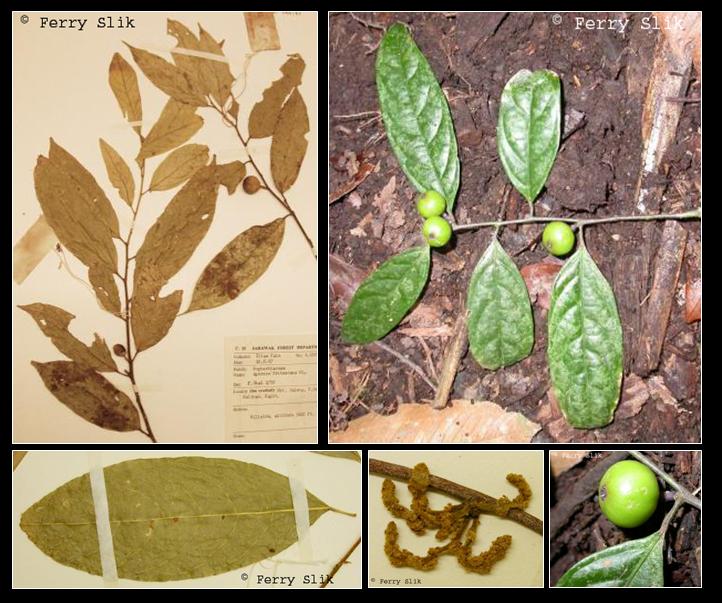Aporosa frutescens Blume, Bijdr. (1825)
Latin for 'shrub-like'.Synonyms
Aporosa fruticosa (Blume) Mull.Arg.
Leiocarpus fruticosa Blume
Diagnostics
Sub-canopy tree up to 22(-27) m tall and 31 cm dbh. Stipules ca. 6 mm long,
dropped early. Leaves alternate, simple, penni-veined, glabrous. Flowers ca. 0.5
mm in diameter, yellow, placed in compressed racemes. Fruits ca. 12 mm long,
yellow-orange-red, dehiscent capsule, seeds with orange aril.
Description
Shrub or tree, up to 27 m high, up to 30 cm diameter. Bark black, (dark) brown chocolate, greyish
brown, grey-green, or (dark) grey, smooth, slightly scaly; inner bark outside (pale) reddish to
pale (yellow) brown, inside turning pale green, pale yellow, or whitish, thin, fibrous. Wood
brownish yellow or pale grey to white. Young branches sparsely hirsute. Stipules narrowly ovate,
oblique, 1.5-2 by 5-7 mm, sparsely hairy outside, present in young stages. Petiole terete, smooth
to adaxially lowly grooved, 4-14 by 0.8-1.5 mm, hirsute, glabrescent, lower pulvinus 1-1.5 by c.
1.5 mm, mostly indistinct, upper pulvinus 2-5 by 1.5-2 mm, distinct. Leaves narrowly ovate to
narrowly elliptic, 6.5-20 by 1.5-7.5 cm; base cuneate to slightly attenuate, basal glands absent;
margin lowly undulate to lowly glandular-crenate, marginal glands regular, small, greyish or
blackish; apex acuminate to cuspidate; blade thin, lowly granular above and beneath, dull, not
brittle, drying greyish green to yellowish green above and beneath, nervation lighter beneath,
very sparsely puberulous, midrib and nerves (sparsely) hirsute, glabrescent; dots irregularly set,
fine, greyish, mostly indistinct; disc-like glands occasionally few, small, along margin. Nervation:
midrib slightly prominent above, prominent beneath; nerves 8-10 pairs, slightly prominent to flat
above, prominent beneath, marginal arches distinct, 1.5-2.5 mm from the margin; tertiary veins and
venation often distinct, rather densely reticulate, slightly prominent to flat above, (slightly)
prominent beneath. Inflorescences axillary or just below the leaves. Staminate inflorescences 1-4
clustered together, 5-22 by 2-3.5 mm, (sparsely) puberulous; peduncle 0.5-1.5 by 0.7-1 mm; bracts
broadly triangular, 0.4-0.7 mm long, inconspicuous, very sparsely hairy outside, glabrescent,
glabrous inside, margin ciliate; glomerules ellipsoid, consisting of 7-10 densely set flowers, c.
2 by 0.5 mm, spaced at 0.5-1 mm at base, apically slightly massed in a cylindric head; pedicel
absent. Staminate flowers 0.3-0.7 mm long; sepals (3 or) 4, obovate, 0.2-0.4 mm long, connate at
base, glabrous, margin ciliate at apex; stamens 2 (or 3), 0.3-0.6 mm long, slightly exserted;
anthers 0.1-0.2 mm long, connective glabrous; pistillode absent. Pistillate inflorescences 1-3
clustered together, 2-7 by 0.7-1 mm, (sparsely) puberulous; flowers single at apical end of rachis;
bracts broadly triangular, 0.5-0.8 mm long, sparsely puberulous outside, glabrous inside; bracteoles
ovate, c. 0.5 mm long, sparsely hirsute outside, glabrous inside; pedicel 1.5-2 mm long, puberulous.
Pistillate flowers 1.5-3 mm long; sepals 5 (or 6), ovate, subequal, reflexed, 1.2-1.5 mm long,
fleshy, sparsely puberulous; ovary ellipsoid, 1.5-2.5 mm, 3-locular, slightly punctulate, sparsely
puberulous to subglabrous; stigmas sessile, broad, apically lowly lobed, flattened on top of ovary,
straight, 0.5-1 mm long, lowly papillate above, glabrous, connate to the ovary beneath.
Infructescences 3-11 by 0.8-1.2 mm, sparsely puberulous, glabrescent; fruiting pedicel 2-6 mm long.
Fruits juicy, globose, often with sunken stigmas, not stiped, not beaked, 9-15 by 10-15 mm, smooth,
drying light or brownish yellow, sparsely puberulous to glabrous; pericarp 0.5-3 mm thick, fleshy;
septae and column glabrous. Seeds 2-4, half-terete, ellipsoid, 8-11 by 6-9 by 3-5 mm. [from Flora
Malesiana: http://www.nationaalherbarium.nl/Euphorbs/specA/AporosaT.htm]
Ecology
Primary, secondary, disturbed, logged over forest and kerangas; on hilltops, hillsides, hill ridges,
along river banks, roads, lakes, and forest margins; in dry, swampy, or shaded areas. Soil: a
granitic or yellow-red loamy sand, red clay, blackish stony or a silty clay brown laterite.
Altitude: 0-1700 m.
Uses
Fruits are edible.
Distribution
Burma, Peninsular Thailand, Peninsular Malaysia, Sumatra, Java, Borneo, Philippines,
Sulawesi, Moluccas.
Local names
Borneo Girak, Kalumanjat, Korosib, Lamog-lamog, Liposu gobuk, Monka-a, Rambai-rambai.
Java Sassa lumbut, sassa benar.
Moluccas Ai mbalute (Ceram).
Philippines Ragsik (Bic.).
Sumatra Kayu si marlilin, kayu si topu aek (east coast); kayu malam (Bangka).
